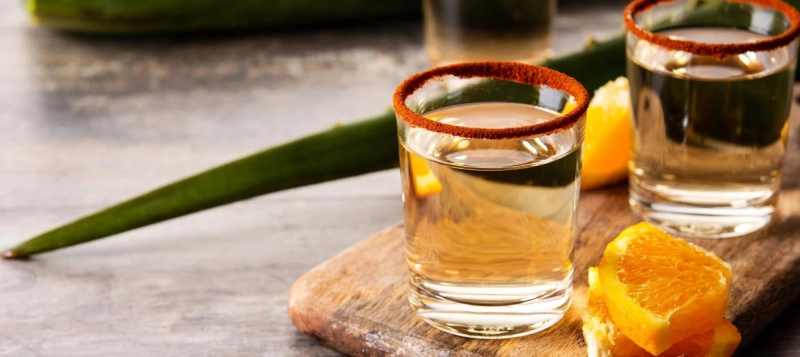When it comes to renowned spirits from around the world, certain names immediately spring to mind. Tequila from Mexico, scotch from Scotland, sake from Japan and schnapps from Germany are among the most well-known.
However, beyond these internationally celebrated spirits, there exists a world of lesser-known but just as enjoyable libations – the second most famous spirits of their respective countries.
In this article, we explore some of the second spirits that deserve a place on your bar cart.
Mezcal
While tequila has earned its place in the global spotlight, mezcal stands as Mexico's second most famous spirit. Crafted from the agave plant in a similar way to tequila, mezcal boasts a rich history that extends back centuries. Tequila, in fact, is a type of mezcal that has outstripped the original spirit in terms of popularity.
But mezcal is a fascinating spirit offers a smoky and complex flavour profile unique unto itself. Produced predominantly in the Oaxaca region of Mexico, which accounts for approximately 85 per cent of the nation's mezcal production, this spirit has witnessed a steady rise in production over the past decade, with growing exports to the United States, Canada and Europe.
Unlike tequila, which can only be made from the blue agave plant, mezcal can be derived from various agave types, yielding a broad spectrum of flavours.
Beyond the wider range of agave plants used, what distinguishes mezcal are its traditional and artisanal production methods, which lend it a diverse and distinctive flavour profile. The piñas, the heart of the agave plant, are roasted in underground pits to give mezcal its characteristic smoky aroma and taste.
And while tequila is distilled only in stainless steel stills, mezcal can be distilled in almost anything, from clay pots to the cured stomach of a cow, further developing the unique palette of flavours.
If you’re already a fan of tequila, it might be time to add Mexico’s second most famous spirit to your repertoire.
Scottish gin
When one thinks of Scotland, scotch whisky naturally springs to mind. Nevertheless, in recent years, gin has begun to gain prominence in the north of the UK.
While not as renowned as scotch, gin has a rich history in the country and is undergoing a revival in Scottish distilleries. The craft gin industry in Scotland has witnessed a boom, and Scotland now produces 70 per cent of the United Kingdom’s gin, with around 100 distilleries located everywhere from the Borders in the south to Shetland in the north.
In fact, three of the world’s best-selling gins (Hendrick's, Gordon's and Tanqueray) are made in Scotland and local craft spirits are growing in popularity, too.
Scottish gins often incorporate botanicals inspired by the country's natural surroundings, including heather, thistle and citrus. Exports of Scottish gin are on the rise, with the United States and Europe serving as key markets.
Scottish gin is characterised by its clean and crisp flavour profile, frequently featuring the influence of locally sourced botanicals. Many Scottish gin producers prioritise sustainability and incorporate foraged or organic botanicals into their production processes. Tours and tastings of gin distilleries in Scotland are popular, providing visitors with an alternative to Scotland’s first spirit while exploring whiskey country.
Shōchū
Japan is celebrated for its sake, a traditional rice wine that has garnered international acclaim. However, Japan's second most famous spirit, shōchū, offers a distinctive alternative. Shochu is a versatile and beloved spirit among many Japanese consumers and is beginning to be recognised globally.
The production of shōchū has been steadily rising, offering a diverse array of flavours and styles for consumers to explore. Shōchū typically undergoes distillation using various base ingredients, such as barley, sweet potatoes, rice and more.
Its lower alcohol content compared to other spirits makes it a lighter and more accessible option for many. The flavour profile of shōchū varies significantly depending on the base ingredient used; for instance, sweet potato shōchū offers a rich and earthy taste, while barley shōchū tends to be milder and more floral.
This lower-calorie, reduced-hangover spirit is popular in Japan as a healthier alternative to other alcoholic beverages and this popularity is moving global.
Korn
When one thinks of German spirits, schnapps often takes centre stage. However, Korn, a traditional German grain spirit, holds the distinction of being Germany's second most famous spirit.
Unrelated to the nu metal band from the ’90, korn is a clear, unaged spirit with a centuries-old legacy in Germany.
Korn is typically crafted from malted barley, wheat or rye, and it must adhere to specific quality standards outlined in the German Spirits Regulation. With over 100 korn distilleries, primarily concentrated in the northern and western regions of the country, this spirit enjoys a loyal following among Germans.
Traditional korn production methods often involve multiple distillations to ensure a smooth and pure final product. As a result, korn is known for its neutral flavour profile, making it an adaptable spirit for mixing in cocktails or enjoying as a shot.
In Germany, it is customary to pair Korn with a beer chaser, a combination known as "herrengedeck”.
Stock the bar cart
While tequila, scotch, sake, and schnapps have long basked in the limelight as their respective countries' most famous spirits, mezcal, gin, shōchū and korn have quietly forged their own legacies.
These “second spirits” offer unique and diverse flavour profiles, gaining them recognition both domestically and internationally.
Whether you're savouring mezcal's smoky complexity in Mexico, relishing a crisp scottish gin, exploring the versatile world of shōchū in Japan or toasting with a shot of korn in Germany, these lesser-known spirits beckon you to embark on a global journey of taste and tradition.


